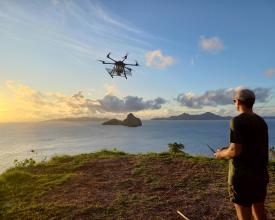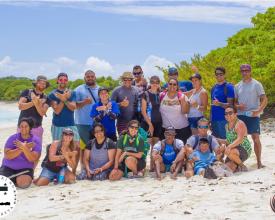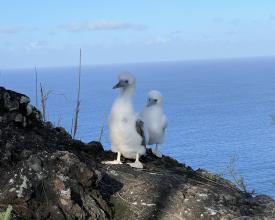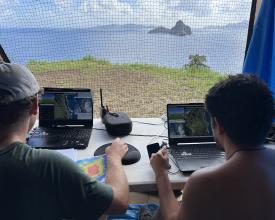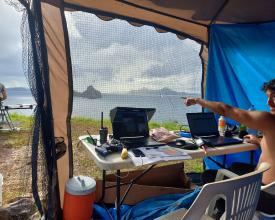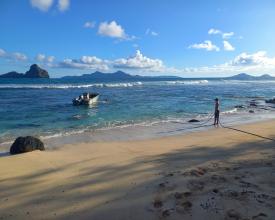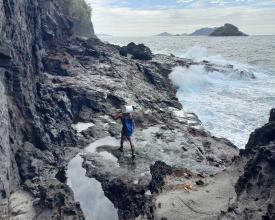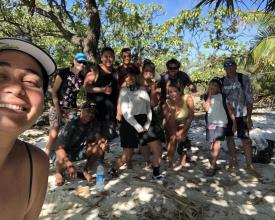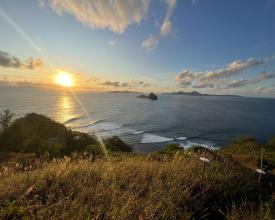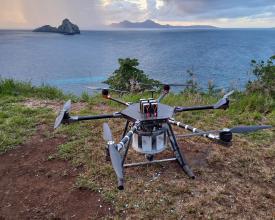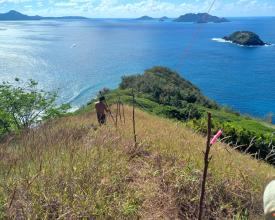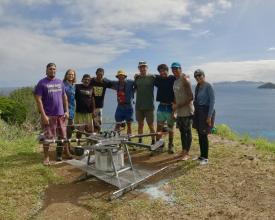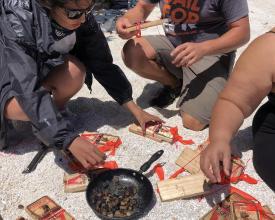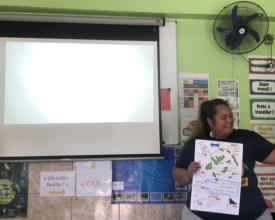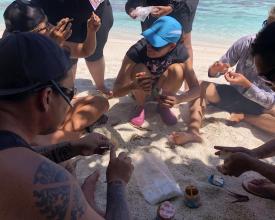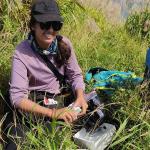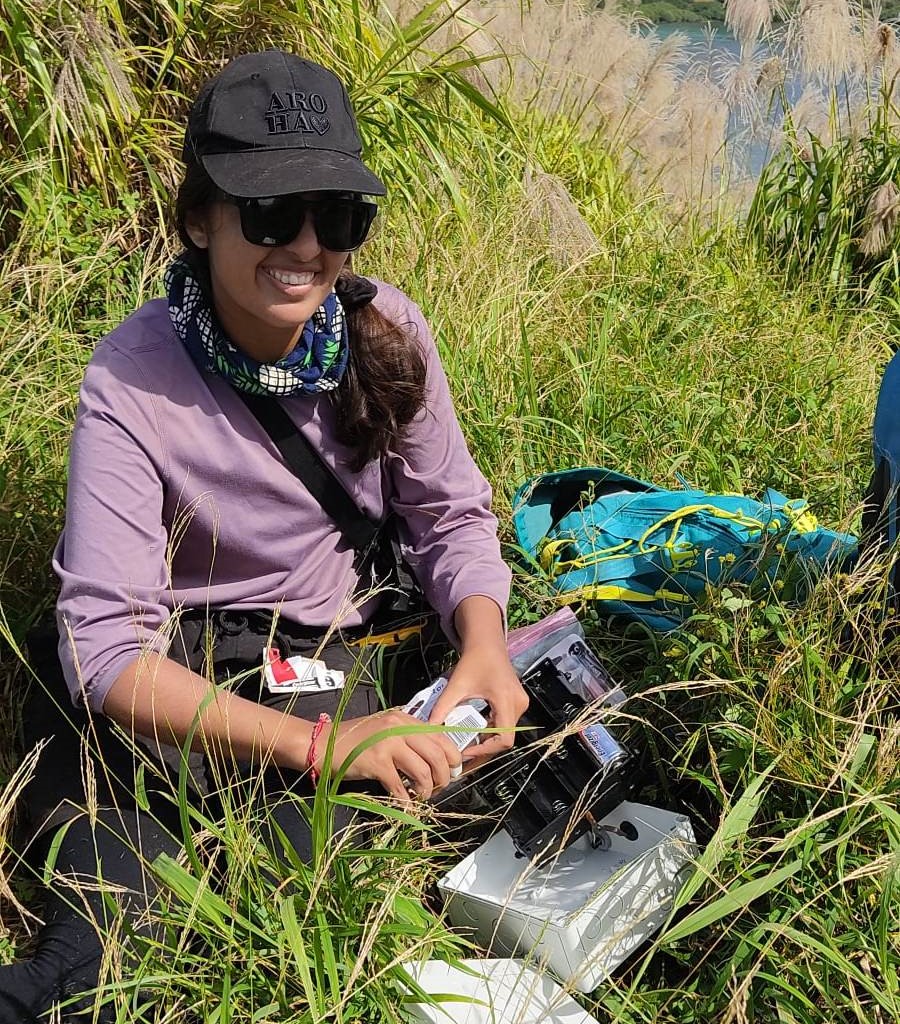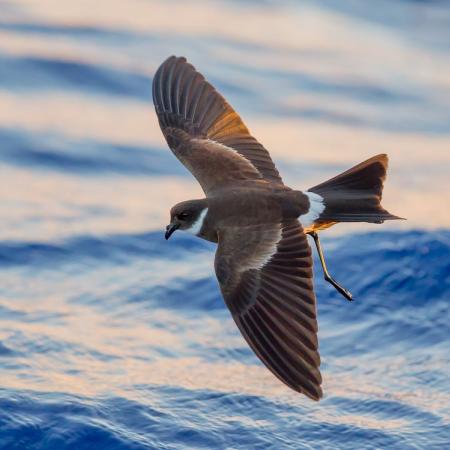
Restoration of Kamaka Island, a sanctuary for Gambier biodiversity

In June 2015, an operation aimed at restoring islands of interest was carried out in the Gambier and Actéons islands. The eradication of the targeted introduced species was a success on all of these islands, except Kamaka, where the eradication of the Pacific rat (Rattus exulans) failed. In 2022, a second attempt via drone aerial baiting was made to preserve this site. It succeeded, and in 2023 rats were no longer found. The project was set up with the help of ENVICO, a drone company based in New Zealand, the landowners of Kamaka, Island Conservation, local members of the community & the Town hall of the Gambier.
By removing rats, the project has contributed to the conservation of rare seabird species, such as the Polynesian Storm-petrel (Nesofregetta fuliginosa) and many other indigenous species of the island. In addition, the local community has benefited from this restoration project through increased natural resources, reduced risk of diseases and increased economic opportunities.
Context
Challenges addressed
- Kamaka is the only island where the large-scale rat eradication operation of 2015 has failed. Once a site has one failed attempt, it is important to assess why and how to counteract the reason why it failed.
- Kamaka is very close geographically to two important nesting sites of Polynesian Storm-petrel: Manui and Teiko islets. Rat presence on Kamaka makes this species unable to nest on the island. It is also a risk that rats would one day swim to these near islets to invade these sites, which would be catastrophic for this endangered seabird species.
- Kamaka hosts many plant species, some very rare, and rats presence stops the development of seedlings
- Kamaka has private owners who had to constantly distribute rodenticide to control rat population around their vegetable gardens and fruit trees. Kamaka is also an important site for local fishermmen for coastal crabs, which rats also eat.
Location
Process
Summary of the process
- Block 1 is the logistical and methodology planning - which was the creation of the organisation plan, a plan that needed to work for our partners (Island Conservation and Envico);
- Block 2 is the project implementation on the field, and the issues that we managed to by-pass since we managed to adapt to the situation rapdirapidly
- Block 3 is related to communication of the project among the local community, and having them involved in the protection of the site.
In Kamaka, a private property and remote island from the villages of Mangareva, the risk of reintroduction of rats is minimal and depends on the visitors of the island (especially on the owners of the island). Biosecurity measures for the safety of the island will still have to be carefully and rigorously monitored.
This type of project would be feasible at other sites in French Polynesia. Kamaka, being the first project by Drone, will serve as an example for other future projects and other important sites for seabirds in Polynesia.
Building Blocks
Development of a compelling Operational & Biosecurity Plan
There were two important steps before starting the implementation of the project:
- The development of an Operational Plan, which consisted of Rat eradication Methodology, Team Roles, Schedules, List of Gear & Materials.
- The development of a Biosecurity Plan, which was shared with the local owners of Kamaka. The plan describes preventive measures - what to do to avoid bringing back rats or other invasive species on the island.
Enabling factors
The development of an operational plan (including rigorous planning) was very important to prepare the project. Without this plan, we would not have been able to organize the logistics and coordinate the schedules of the different teams from SOP Manu, Island Conservation and Envico. SOP Manu's role was to organize local logistics and the fieldwork with hiring local team members, while Island Conservation brought in their expertise on rat eradication projects and ENVICO technologies (drone company) were the ones who were the technical experts flying the drone.
Lesson learned
- Had it not been for the delay in reopening the NZ borders, we could have organized better the logistics of this project.
- We learned that even with an operational plan, a very thorough communication effort has to be made between the different structures for organizing this type of project that requires a lot of logistical support.
Use of cutting-edge technology for project implementation
After an initial delay, the rat eradication operation was conducted in two campaigns between May 31st and July 3rd 2022, with a gap of 17 days between them. Aerial broadcast of bait containing brodifacoum at 25ppm was carried out by drone (UAV), which was more economical than a helicopter but presented significant operational challenges. The two campaigns were each completed at a minimum target rate of 30kg per hectare, with higher application rates applied along the coast and on steep faces. Baiting was supplemented by hand on the rocky coastline and steep faces. Buildings were treated by hand-baiting and bait stations. A total of 7,183.65 kg of bait was applied, 6210 kg by drone and 973.65 kg by hand. Eight full bags of bait (181.6 kg) were left securely stored in case it is required for a biosecurity response.
Enabling factors
- The use of cutting-edge technology for the eradication campaigns.
- The collaboration of experts in invasive species eradication, especially in managing the Envico drone pilots.
- The effective deployment of logistics.
Lesson learned
- Cables should have rat protection: A logistical problem arose during the first bait distribution attempt - the fiber-optic cable linking with the drone (via an antenna) was severed by a rat chew, slowing down the project. To overcome this, a new heavier duty cable had to be sourced from the US.
- For future projects, more duplicate parts needs to be brought in to replace parts that break or fail, as it is really difficult to source gear rapidly in Tahiti.
- It is essential to have alternative operational sites: another issue was that we had to move the drone’s take-off point to a site at 100 meters altitude. Indeed, the site selected on the coast for the take-off area resulted in an overshoot of flight time.
- There is always a logistical solution – due to moving sites, we had to find a way to rapidly transport nearly 7 tons of rodenticide. This problem was overcome by the installation of a temporary 70 m high zipline to transfer rodenticide bags (20 kg each). This device allowed the rodenticide to be transported in 4 days, by only 6 people, thanks to the support of members of the local community.
Raise awareness of the local community on indigenous species, threats and biosecurity measures
There were two training sessions of the local NGO Toromiki no Mangareva conducted by SOP Manu. The NGO was recently created to protect the fauna and flora of Mangareva and the surrounding uninhabited islets and to involve children of the island in the protection of the environment. The two training sessions with Toromiki no Mangareva were an opportunity to spread knowledge and talk about the Kamaka restoration project. Many members are primary and secondary school teachers from Mangareva, who were able to deliver key messages to children of the island about seabirds, their threats and biosecurity.
Several members of the NGO are active members of the Gambier community (employees of the town hall, the Air Tahiti office, school teachers, and firefighters), and therefore have a lot of influence on the local population. Their involvement through training will help protect Kamaka in the future – as they were asked to communicate about this project and biosecurity measures to the local community.
Enabling factors
- Involve the local community in relevant training.
- Communicate and raise awareness effectively among the locals.
Lesson learned
- The theoretical interventions allowed the members to acquire knowledge of the different means of communication of biosecurity and the importance of birds to the community.
- The development of Mock-ups for biosecurity, Information posters and information brochures signs in groups was very useful and made local people participate in their own way in the conservation project.
- The visits on the field had allowed members to gain field experience in bird recognition and learn techniques for monitoring invasive species (via the use of rat snap-traps or chewing cards).
- Barry Mamatui also participated in the training (essential local team member who participated in the Kamaka eradication project and has been trained by SOP Manu since 2015), which allowed Toromiki no Mangareva members to recognize the importance of having local people trained for this type of work. His presence was important as he shared his experience on the field and his knowledge of the sites and seabirds.
Impacts
- Rat eradication was successful on Kamaka and local capacities were increased for SOP Manu, owners of the island and local workers.
- Monitoring of the absence of rats on indigenous species was completed on: (1) bird species present and reproductive success, (2) the proportions of seeds and seedlings (of Koariki Terminalia glabatra) on the ground, (3) the abundance of mosquitoes and (4) the abundance of coastal crabs.
- Most significant impacts collected during monitoring was on plants (seeds and seedlings) and crabs, which numbers have increased significantly since the eradication project
- As for seabirds, it is difficult for now with the time allocated by the grant to really measure a significant impact, as there are different breeding seasons, meaning that the data is very variable. Long-term monitoring will be needed in the future.
- Mosquitoes numbers don't seem to have reduced in numbers as of yet.
- Two successful training sessions of a local environmental NGO (Toromiki no Mangareva) was completed. Topics were Seabirds identification methods, threats and conservation actions (i.e. biosecurity measures).
Beneficiaries
- Kamaka seabirds, indigenous plants and insects, as main beneficiaries.
- Kamaka local owners and their families, since now they can eat fruits and vegetables produced on the island. The locals will have increased resources in coastal crabs.
Story

Kamaka was bought by Johnny Reasin’s father in the 1960s. The family lived there for many years and built two houses, a pond and other structures. Since the 1990s, Johnny became the owner and was the only permanent resident of Kamaka. In June -July 2015, Kamaka was part of a larger operation led by SOP Manu, BirdLife International and Island Conservation, targeting nine populations of five species of invasive alien vertebrate at a total of six sites in the Acteon group and the Gambier archipelago. All target pest populations were successfully removed except for the R. exulans population on Kamaka. A genetic analysis confirmed the rats found a year later were survivors of the target population.
Unfortunately, Johnny passed away in late 2017 and is now buried in Kamaka. Since then, Tehotu Reasin, Jonny’s son, is the new joint owner (with his sister). Like his late father, Tehotu supports the restoration of Kamaka to benefit the native flora and fauna.
Kamaka has no reef protection to the South and as such is exposed to southerly weather conditions and in particular the Southeast trade winds (‘Mara’amu’; begins at the end of April and last till October‐November) which often produce sea conditions preventing access by boat for several weeks at a time during this period. The mostly rocky coastline is a mix of cliffs with overhangs, gentler slopes, boulder piles and rocky intertidal zones; the only sandy beach is at the north of the island, which is the only access point.
Kamaka Island is not an easy island to work on, but it is very beautiful and is an important breeding ground for many seabirds, such as the 'Karako' (Tropical Shearwater), 'Kokokoko' (Christmas shearwater), 'Noha' (Tahiti Petrel), etc. All seabirds have local names in the Mangareva language, meaning that they were important for the local culture of the Gambier Archipelago. SOP Manu and many locals that have worked on the restoration of Kamaka, dream that the small ‘Kotai’ (Polynesian Storm-Petrel), which only breeds on nearby Manui and Teiko Islets, will one day come back to breed on Kamaka! I also consider myself a privileged person to be able to work there. When I hike to the top of the island and look at the beautiful view, I think about all of our conservation efforts and hope that this island becomes a sanctuary for many seabirds in the future.

